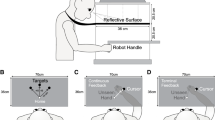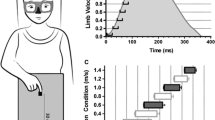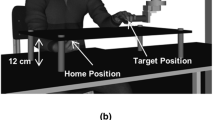Abstract
Control of familiar visually guided movements involves internal plans as well as visual and other online sensory information, though how visual and internal plans combine for reaching movements remain unclear. Traditional motor sequence learning tasks, such as the serial reaction time task, use stereotyped movements and measure only reaction time. Here, we used a continuous sequential reaching task comprised of naturalistic movements, in order to provide detailed kinematic performance measures. When we embedded pre-learned trajectories (those presumably having an internal plan) within similar but unpredictable movement sequences, participants performed the two kinds of movements with remarkable similarity, and position error alone could not reliably identify the epoch. For such embedded movements, performance during pre-learned sequences showed statistically significant but trivial decreases in measures of kinematic error, compared to performance during novel sequences. However, different sets of kinematic error variables changed significantly between learned and novel sequences for individual participants, suggesting that each participant used distinct motor strategies favoring different kinematic variables during each of the two movement types. Algorithms that incorporated multiple kinematic variables identified transitions between the two movement types well but imperfectly. Hidden Markov model classification differentiated learned and novel movements on single trials based on the above kinematic error variables with 82 ± 5% accuracy within 244 ± 696 ms, despite the limited extent of changes in those errors. These results suggest that the motor system can achieve markedly similar performance whether or not an internal plan is present, as only subtle changes arise from any difference between the neural substrates involved in those two conditions.







Similar content being viewed by others
References
Ariff G, Donchin O, Nanayakkara T, Shadmehr R (2002) A real-time state predictor in motor control: study of saccadic eye movements during unseen reaching. J Neurosci 22:7721–7729
Ashe J, Lungu OV, Basford AT, Lu X (2006) Cortical control of motor sequences. Curr Opin Neurobiol 16:213–221
Bapi RS, Doya K, Harner AM (2000) Evidence for effector independent and dependent representations and their differential time course of acquisition during motor sequence learning. Exp Brain Res 132:149–162
Bapi RS, Kiyapuram KP, Graydon FX, Doya K (2006) fMRI investigation of cortical and subcortical networks in the learning of abstract and effector-specific representations of motor sequences. NeuroImage 32:714–727
Bhat R, Sanes JN (1998) Cognitive channels computing action distance and direction. J Neurosci 18:7556–7580
Diedrichsen J, Hashambhoy Y, Rane T, Shadmehr R (2005) Neural correlates of reach errors. J Neurosci 25:9919–9931
Duhamel J-R, Colby CL, Goldberg ME (1992) The updating of the representation of visual space in parietal cortex by intended eye movements. Science 255:90–92
Geman S, Kochanek K (2001) Dynamic programming and the graphical representation of error-correcting codes. IEEE Trans Inf Theory 47:549–568
Grafton ST, Hazeltine E, Ivry RB (1998) Abstract and effector-specific representations of motor sequences identified with PET. J Neurosci 18:9420–9428
Hikosaka O, MK R, Miyachi S, Miyashita K (1995) Learning of sequential movements in the monkey: process of learning and retention of memory. J Neurophys 74:1652–1661
Karni A, Meyer G, Jezzard P, Adams M, Turner R, Ungerleider LG (1995) Functional MRI evidence for adult motor cortex plasticity during motor skill learning. Nature 377:155–158
Klein Breteler MD, Hondzinski JM, Flanders M (2003) Drawing sequences of segments in 3D: kinetic influences on arm configuration. J Neurophysiol 89:3253–3263
Lungu OV, Wächter T, Liu T, Willingham DT, Ashe J (2004) Probability detection mechanisms and motor learning. Exp Brain Res 159:135–150
Miall RC, Jackson JK (2006) Adaptation to visual feedback delays in manual tracking: evidence against the Smith Predictor model of human visually guided action. Exp Brain Res 172:77–84
Moran DW, Schwartz AB (1999) Motor cortical representation of speed and direction during reaching. J Neurophysiol 82:2676–2692
Morasso P (1981) Spatial control of arm movements. Exp Brain Res 42:223–227
Nissen MJ, Bullemer P (1987) Attentional requirements of learning: evidence from performance measures. Cogn Psych 19:1–32
Paninski L, Fellows MR, Hatsopoulos NG (2004) Spatiotemporal tuning of motor cortical neurons for hand position and velocity. J Neurophysiol 91:515–532
Poldrack RA, Sabb FW, Foerde K, Tom SM, Asarnow RF, Bookheimer SY, Knowlton BJ (2005) The neural correlates of motor skill automaticity. J Neurosci 25:5356–5364
Press SJ (1989) Bayesian statistics: principles models and applications. Wiley, New York
Rabiner LR (1989) A tutorial on hidden Markov models and selected applications in speech recognition. Proc IEEE 77:257–286
Robertson EM (2007) The serial reaction time task: implicit motor skill learning? J Neurosci 27:10073–10075
Sakai K, Hikosaka O, Miyauchi S, Takino R, Sasaki Y, Pütz B (1998) Transition of brain activation from frontal to parietal areas in visuomotor sequence learning. J Neurosci 18:1827–1840
Shadmehr R, Mussa-Ivaldi FA (1994) Adaptive representation of dynamics during learning of a motor task. J Neurosci 14:3208–3224
Shadmehr R, Wise SP (2005) The computational biology of reaching and pointing: a foundation for motor learning. MIT Press, Cambridge
Wang T, Dordevic GS, Shadmehr R (2001) Learning the dynamics of reaching movements results in the modification of arm impedance and long-latency perturbation responses. Biol Cybern 85:437–448
Wang W, Chan SS, Heldman DA, Moran DW (2007) Motor cortical representation of position and velocity during reaching. J Neurophysiol 97:4258–4270
Wessberg J, Perfiliev S, Fridlund M (2006) Continuous arm guidance by a visual target during high-speed tracking. Program No. 440.11. 2006 Neuroscience Meeting Planner. Society for Neuroscience, Atlanta, GA (online)
Willingham DB, Salidis J, Gabrieli JDE (2002) Direct comparison of neural systems mediating conscious and unconscious skill learning. J Neurophysiol 88:1451–1460
Acknowledgments
John P. Donoghue: NIH-NINDS NS-25074 (Javits). Jerome N. Sanes: NIH-NINDS R01NS44834.
Author information
Authors and Affiliations
Corresponding author
Rights and permissions
About this article
Cite this article
Philip, B.A., Wu, Y., Donoghue, J.P. et al. Performance differences in visually and internally guided continuous manual tracking movements. Exp Brain Res 190, 475–491 (2008). https://doi.org/10.1007/s00221-008-1489-3
Received:
Accepted:
Published:
Issue Date:
DOI: https://doi.org/10.1007/s00221-008-1489-3




